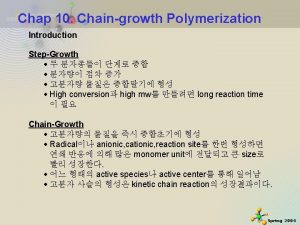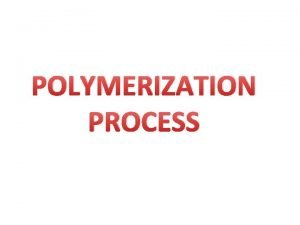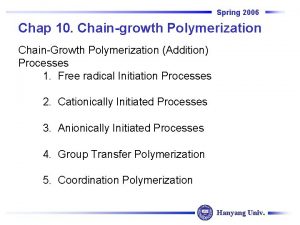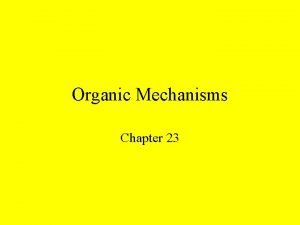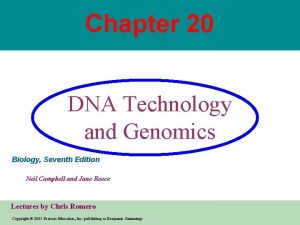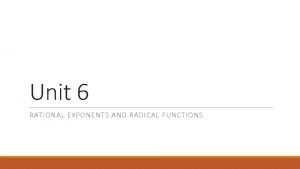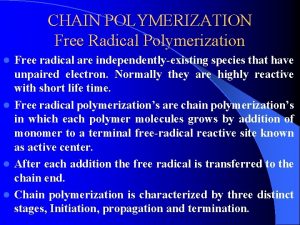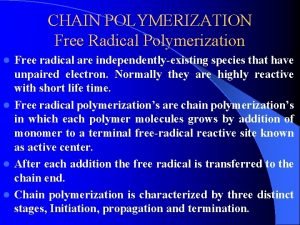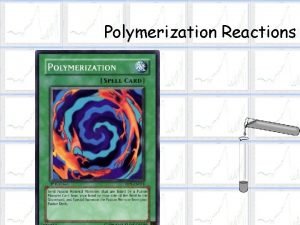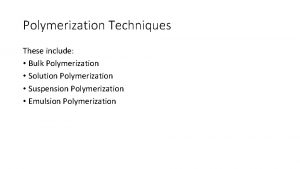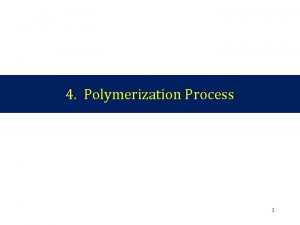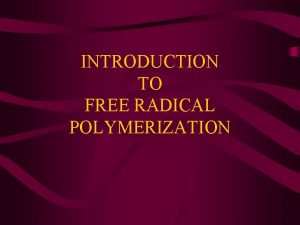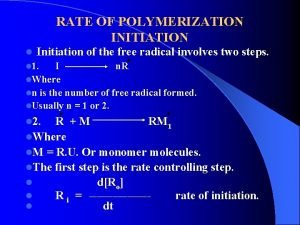Radical polymerization initiation propagation chain transfer termination start









![When the initiator decomposes slowly compared to the entire polymerization process: When ln([M]0/[M]) is When the initiator decomposes slowly compared to the entire polymerization process: When ln([M]0/[M]) is](https://slidetodoc.com/presentation_image_h2/cbcbe357562ba6d93284698ee60bd4e6/image-10.jpg)
![Kinetic chain length Also =kp [M] , with t time of growth of a Kinetic chain length Also =kp [M] , with t time of growth of a](https://slidetodoc.com/presentation_image_h2/cbcbe357562ba6d93284698ee60bd4e6/image-11.jpg)
- Slides: 11

Radical polymerization • • initiation propagation chain transfer termination (start) (growth) (stop/start) (stop) During initiation active centers are being formed. During termination active centers disappear. Concentration of active centers is very low (10 -9 - 10 -7 mol/L). Growth rate of a chain is very high (103 - 104 units/s). Chains with a degree of polymerization of 103 to 104 are being formed in 0. 1 to 10 s. 1

Initiation Most common method of initiation: thermal decomposition of a thermally labile compound, the initiator These radicals are called primary radicals. Initiation takes place by addition of a monomer unit. kd is a first order rate constant. Common values of kd are in the range: 10 -4 - 10 -6 s-1. The rate of radical production is then given by: 2

The actual rate of initiation Ri is expressed in terms of the rate of radical production that leads to actual polymer chains growing!: where f is the efficiency factor: the fraction of radicals that really leads to initiation. Therefore, in all cases: f 1 The rate constant ki is not used in the mathematical description of the polymerization. Examples of thermal initiators: Ea = 140 – 160 k. J mol-1 3

propagation This reaction is responsible for the growth of the polymer chain. It is the reaction in which monomer is added at the active center: The rate of this reaction Rp can be expressed as: Assumption: the reaction rate constant kp is independent on chain length. This appears to be reasonable above chain length i = 5 - 10 Propagation is the most important reaction for monomer consumption. The reaction rate constant kp typically has a value in the range 102 104 L/mol s 4

Termination Chain growth stops by bimolecular reaction of two growing radicals: termination Traditionally two different reactions are recognized: • termination by combination (ktc) • termination by disproportionation (ktd) Schematically these reactions can be represented as: The general kinetic equation reads: The reaction rate constant kt is in the range 106 - 108 L/mol s 5

Termination Every reaction consists of two steps: 1) approach of both reactants 2) chemical reaction The second step in the termination reaction is very fast. This means that the rate of approach (partially) determines the overall termination rate. 6

Termination: which is faster? 1. + or + 2. + or + in a viscous medium 3. + at 5 % conversion in a non-viscous medium or + at 85 % conversion 7

Rate of polymerization The rate of polymerization in a chain growth polymerization is defined as the rate at which monomer is consumed. Since for the production of high molar mass material Rp » Ri this equation can be re-written as: From the beginning of the polymerization: • increasing number of radicals due to decomposition of the initiator • increasing termination due to increasing radical concentration (R t µ [M·]2) • eventually a steady state in radical concentration: 8

This steady state assumption leads to: From which the differential rate equation is derived: At low conversion this means: log(Rp) vs log[M] yields a slope = 1 log(Rp) vs log[I] yields a slope = 0. 5 9
![When the initiator decomposes slowly compared to the entire polymerization process When lnM0M is When the initiator decomposes slowly compared to the entire polymerization process: When ln([M]0/[M]) is](https://slidetodoc.com/presentation_image_h2/cbcbe357562ba6d93284698ee60bd4e6/image-10.jpg)
When the initiator decomposes slowly compared to the entire polymerization process: When ln([M]0/[M]) is plotted versus time, then the slope should equal k: 10
![Kinetic chain length Also kp M with t time of growth of a Kinetic chain length Also =kp [M] , with t time of growth of a](https://slidetodoc.com/presentation_image_h2/cbcbe357562ba6d93284698ee60bd4e6/image-11.jpg)
Kinetic chain length Also =kp [M] , with t time of growth of a polymer chain Here we find at low conversion: log(n) vs log[M] yields a straight line; slope = 1 log (n) vs log[I] similar; slope = -0. 5 thus: increase in [I] leads to an increase in rate of polymerization and a decrease in chain length. The special case with a slowly decomposing initiator leads here to: where 11
 Kinetic chain reaction
Kinetic chain reaction Solution polymerization
Solution polymerization Is responsible for all file i/o initiation and termination
Is responsible for all file i/o initiation and termination Kinetic chain reaction
Kinetic chain reaction Free radical substitution mechanism
Free radical substitution mechanism Carothers equation
Carothers equation Chain termination method
Chain termination method Grazing food chain diagram
Grazing food chain diagram What is an entire radical
What is an entire radical Unit 6 test study guide radical functions answer key
Unit 6 test study guide radical functions answer key Entire radical examples
Entire radical examples Site:slidetodoc.com
Site:slidetodoc.com
